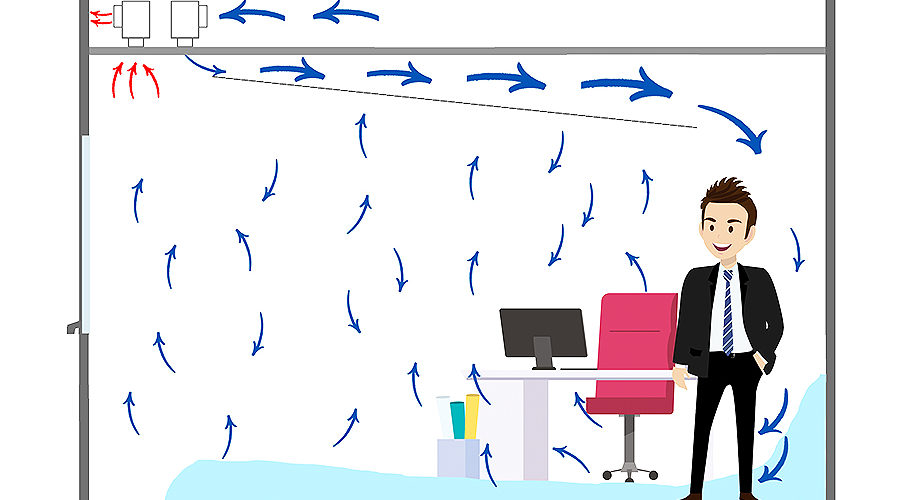Exposed ceilings are an increasingly popular design feature for today’s architects and interior specialists, but achieving adequate comfort conditions in rooms of this type involves a number of technical challenges.
TROX UK
The absence of a ceiling surface creates inevitable challenges in relation to air movement and acoustics, which can lead to unwelcome noise levels, uneven temperatures and draughts. So, how do you overcome the air distribution and acoustical challenges? Tim Tanner, Product Technical Manager – Ventilation Technology at TROX UK, investigates.
Firstly, the air conditioning system needs to be carefully designed to avoid problems associated with ‘dumping’ of cold air into the room. With a typical air distribution system, the supply air ‘attaches’ to the ceiling due to the low-pressure differential between the jet and the ceiling (Coanda effect). This keeps the cooler and denser supply air higher for longer. As it travels, the jet of air expands and mixes with the warmer room air reducing the temperature differential and the velocity. So when it hits the wall (figure 1) or a jet travelling from the opposite direction (figure 2) and descends into the occupied zone, it is more comfortable for the room occupant.
Standard ceiling diffusers are only designed to work with an adjacent ceiling surface. If the ceiling system is removed, for an exposed ceiling, almost all standard diffusers will be unable to function correctly. The loss of Coanda effect/ceiling attachment will result in near vertical discharge of cooler air into the space, resulting in insufficient time for air to mix.
Even with a high discharge velocity and pressure, diffusers may still dump without a ceiling to provide the Coanda effect. If the distance from the air discharge to the occupant is not sufficient, the air will not mix, resulting in excessive velocity (high air speed), excessive temperature differential (large difference between room and supply air) and a high risk of draughts. This would make it difficult to achieve the required comfort conditions. ISO 7730 states a DR of <20% is necessary for a CAT B environment.
Furthermore, if the system is required to provide heating to the space as well as cooling, there are additional challenges to be overcome. Without a suspended ceiling, the warm air is free to stratify. As a result, the space above the diffusers will be heated before the occupied zone, wasting energy, slowing the rate temperature change and possibly creating discomfort (due to high temperature gradients between head and ankle).
Lastly, exposed ceilings are also associated with acoustic unpredictability. Without the normal subdivision of zones between the works of a room and the occupants of a room, a poorly-thought-through design can create large amounts of reverberating noise. Suspended ceilings are typically constructed from metal tiles, which incorporate acoustic materials that absorb sound, minimising noise and reducing the reverberation time within the occupied space. Without these materials in the vicinity of building services, especially in former industrial environments with hard walls, ambient noise stays around and creates an exponential problem for occupants.
Solutions – air management for cooling
In order to achieve effective cooling in exposed ceiling environments, the key is careful selection and placement of diffusers that incorporate their own geometry to form Coanda jets. For example, the TROX Tellus swirl diffuser works differently from most diffusers on the market, as it has a gap between the diffuser face and the plenum that allows for the air to discharge horizontally and form a Coanda jet. The air flowing through the swirl pattern face connects to this jet, increasing the throw distance. For high rooms, Tellus can be provided with a centre-punched face for vertical air discharge. Another option is the TROX RFD swirl diffuser.
This has an increased diameter discharge nozzle (Dx Face), which ensures the diffuser works well in an exposed application without requiring high discharge velocities and pressures.
Solutions – air management for both cooling and heating
Variable geometry diffusers are particularly effective where the room requires both heating and cooling. The new TROX RFD-V, for example, is designed with a thermal actuator and an internal mechanism to manage air more effectively. An adjustable internal sleeve enables the unit to move between horizontal and vertical air discharge, depending on whether the system needs to cool or warm the space. During cooling, the air discharge is horizontal and radial. As the supply temperature increases, the discharge pattern will switch automatically to vertical, directing warmer air more effectively into the occupied space. Once the supply temperature decreases, the air discharge switches back to horizontal once more. These changes to air discharge are controlled by an integral thermal actuator within the diffuser which, in turn, controls the internal sleeve. The supply air to room air temperature difference may range from -10 to +15K. By facilitating the ability to move automatically between cooling and heating, a variable geometry diffuser enables the comfort conditions for the occupied space to be managed much more effectively.
Solutions – acoustics
Effective control of acoustics in rooms with exposed services is made possible by assessing the acoustic requirements of the room to calculate a direct noise contribution.
This includes assessment for:
• % leaving outlet
• Distance to listener
• Directivity
• Reverberation time.
With the correct selection and placement of equipment, together with the intelligent use of silencers etc., the problem can be mitigated, but the key is assessing and designing for acoustic management carefully within the assessment phase.











